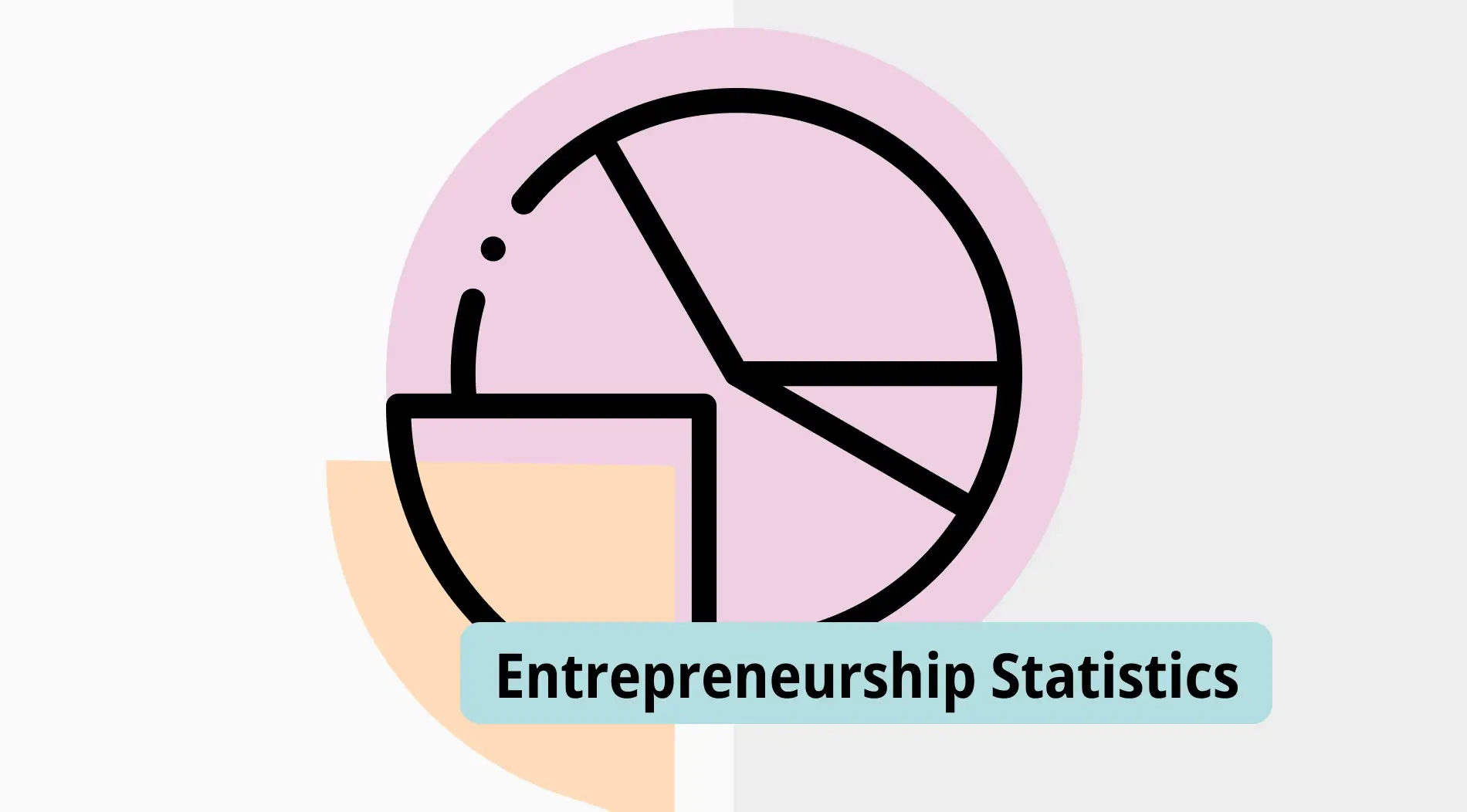In today's business world, entrepreneurship is becoming more important and is preferred by all segments of society. The freedom and creativity of starting a business are the main factors that push people to entrepreneurship. Thanks to entrepreneurship, new business opportunities are created, and economic growth is achieved.
Enterprises established by taking the proper steps provide entrepreneurs with great financial returns and put them ahead of their competitors. In this article, we have compiled 120+ entrepreneurship statistics for you. Thanks to these statistics, you will be able to make comparisons and draw a path for yourself to be successful.
120+ Amazing entrepreneurship statistics to get insightful ideas
Entrepreneurship gives you freedom and the opportunity to be your own boss. The 120+ social entrepreneurship statistics we have compiled will guide you in this regard. Thanks to our categorized statistics, you will learn the subject in detail. Now, let's take a look at our statistics on entrepreneurship:
Entrepreneurship growth statistics
In recent years, the number of people who prefer to establish their own businesses has increased significantly. The growth of entrepreneurship has many advantages for both individuals and society. Now, take a look at some eye-opening statistics on entrepreneurship growth:
1. In the next three to five years, 70% of American business owners anticipate experiencing at least a 25% growth rate (GoDaddy).
2. 83% of entrepreneurs report not currently utilizing AI for their business. However, just 17% of respondents said they were using AI in their company's operations (Guidant Financial).
3. After 10 years, over 35% of enterprises are still operating, 18.4% close within the first year, and almost 50% close by the fifth (North One).
4. 72% of small business owners are unaware of their businesses' credit scores (Mantra).
5. Entrepreneurs make up 88% of millionaires (Zippia).
6. Approximately 1.02 million businesses closed permanently, while 1.07 million small businesses launched for business for the first time in 2020 (US Small Business Administration Office of Advocacy).
7. 63% of Americans who work for themselves think their quality of life is more important than money, and 55% claim to make more money this way (FreshBooks).
8. A third of entrepreneurs launch companies that are owned or run by families (Zippia).
9. There is an 18% success rate for first-time small business entrepreneurs (Exploding Topics).
10. Between 2013 and 2023, small enterprises accounted for 55% of the net job creation (Bureau of Labor Statistics).
11. 14% of entrepreneurs started their own businesses to follow their passions. 11% also stated that they became business owners because an opportunity presented itself (Guidant Financial).
12. Just 1% of the average business's revenue goes toward advertising (North One).
13. The average age of an entrepreneur is 44 (Zippia).
14. 51% of respondents say that starting a business is the greatest method to learn about entrepreneurship (SongBird).
15. From the financial services industry to agriculture, social entrepreneurs are generating 200 million new employment (World Economic Forum).
16. 86.3% of small business owners claimed to make less than $100,000 annually (Fundera).

Source: Zippia
Entrepreneur infographic statistics
It is possible to obtain important information about entrepreneurship through statistics and infographics. In this way, you can discover and use instruments and tools for entrepreneurs. The results you draw from statistics will contribute to your company's success. Here are entrepreneur infographics statistics:
17. Compared to baby boomers, millennials are almost twice as likely to anticipate 50% business growth in the next three to five years (GoDaddy).
18. At $96,623 per year, entrepreneurs with a master's degree make more money than those without one (Zippia)
19. 60% of small business owners lack confidence in their finance and accounting skills (National Business Capital).
20. Approximately 23.2 million companies in the non-financial business services industry were anticipated to operate in the European Union in 2022, up from 22.65 million in 2021 (Statista).
21. Approximately 75% of entrepreneurs stated that they were very or somewhat happy (North One).
22. If their careers ended today, 61% of entrepreneurs would be satisfied with their accomplishments and ready to retire (FreshBooks).
23. The number of business owners who said that hiring and retention were very difficult dropped 52% compared to prior years (Guidant Financial).
24. The fifteen-year survival rate of small businesses was 25.6% between 1994 and 2020. (US Small Business Administration Office of Advocacy).
25. 11.2% of entrepreneurs use a bank loan to fund their business (North One).
26. Compared to public companies, entrepreneurs are 77% more likely to work for private companies (Zippia).
27. 73% of entrepreneurs said they are either highly pleased (36%) or somewhat satisfied (37%) in their roles as business owners. 15% of those surveyed said they felt neutral (Guidant Financial).
28. 58% of small company owners started their companies themselves (Zippia).
29. In the United States, 6% of entrepreneurs in 2022 were between the ages of 20 and 30 (Statista).
30. 92% of entrepreneurs surveyed stated they had no regrets about launching their company (Fundera).
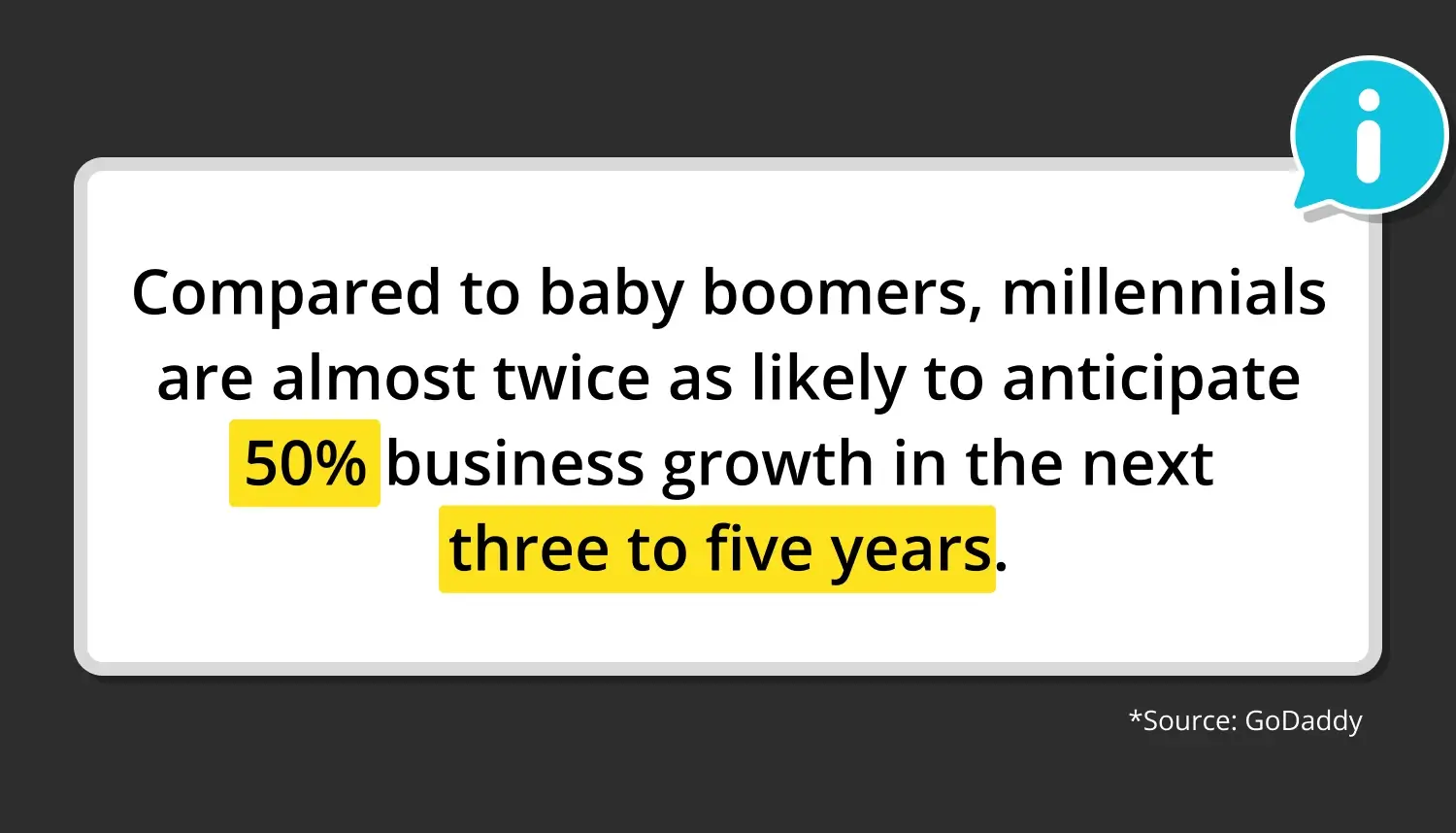
Source: GoDaddy
Female entrepreneurship statistics
Female entrepreneurs contribute to their sectors with their innovative ideas. Their success improves the local and national economy and helps society to progress. Supporting and encouraging female entrepreneurs is necessary for the development of the economy. Here are statistics of success by female entrepreneurs:
31. The largest percentage of female entrepreneurs are between the ages of 40 and 59 (Tech Report).
32. People and communication skills ranked as the most critical component of success for female entrepreneurs, with 37% (Apollo Technical).
33. One in six women worldwide stated that they planned to launch a business soon (Global Entrepreneurship Monitor).
34. In 2022 and 2023, Colombia had the highest percentage of female entrepreneurs (26%) among OECD nations (Statista).
35. During the previous year, about 80% of female entrepreneurs had taken action to reduce their company's environmental impact (Global Entrepreneurship Monitor).
36. A recent survey found that women started 49% of new firms in the US in 2021, up from 28% in 2019 (World Economic Forum).
37. 88% of women-owned firms make less than $100,000 in revenue annually (Tech Report).
38. In the months since March 2020, the percentage of female microbusiness owners has increased from 32% to 39.8% (GoDaddy).
39. There are between 8 and 10 million official small and medium-sized businesses (SMEs) in developing nations with at least one female owner (The World Bank).
40. In 2021, the US received 69.9 index points for encouraging female entrepreneurs globally, closely followed by Canada and New Zealand (Statista).
41. Approximately 50% of female entrepreneurs stated that they have taken action to optimize their companies' social impact (Global Entrepreneurship Monitor).
42. Compared to 44% of males, 47% of women had launched a business in the previous year (Tech Report).
43. Compared to 63% of US male entrepreneurs, 80% of US female entrepreneurs manage their own IT requirements (GoDaddy).
44. According to the World Economic Forum's Global Gender Gap Report 2022, the pandemic is still having a more significant effect on women than males (World Economic Forum).
45. Businesses with gender-diverse leadership teams are 25% more likely to achieve above-average profitability (Luisa Zhou).
46. In 2019, 1.2 million employer enterprises were owned by female entrepreneurs, accounting for 21.7% of all employers (US Small Business Administration Office of Advocacy).
47. Compared to 1 in 5 conventional businesses, women lead 1 in 2 social enterprises globally (World Economic Forum).
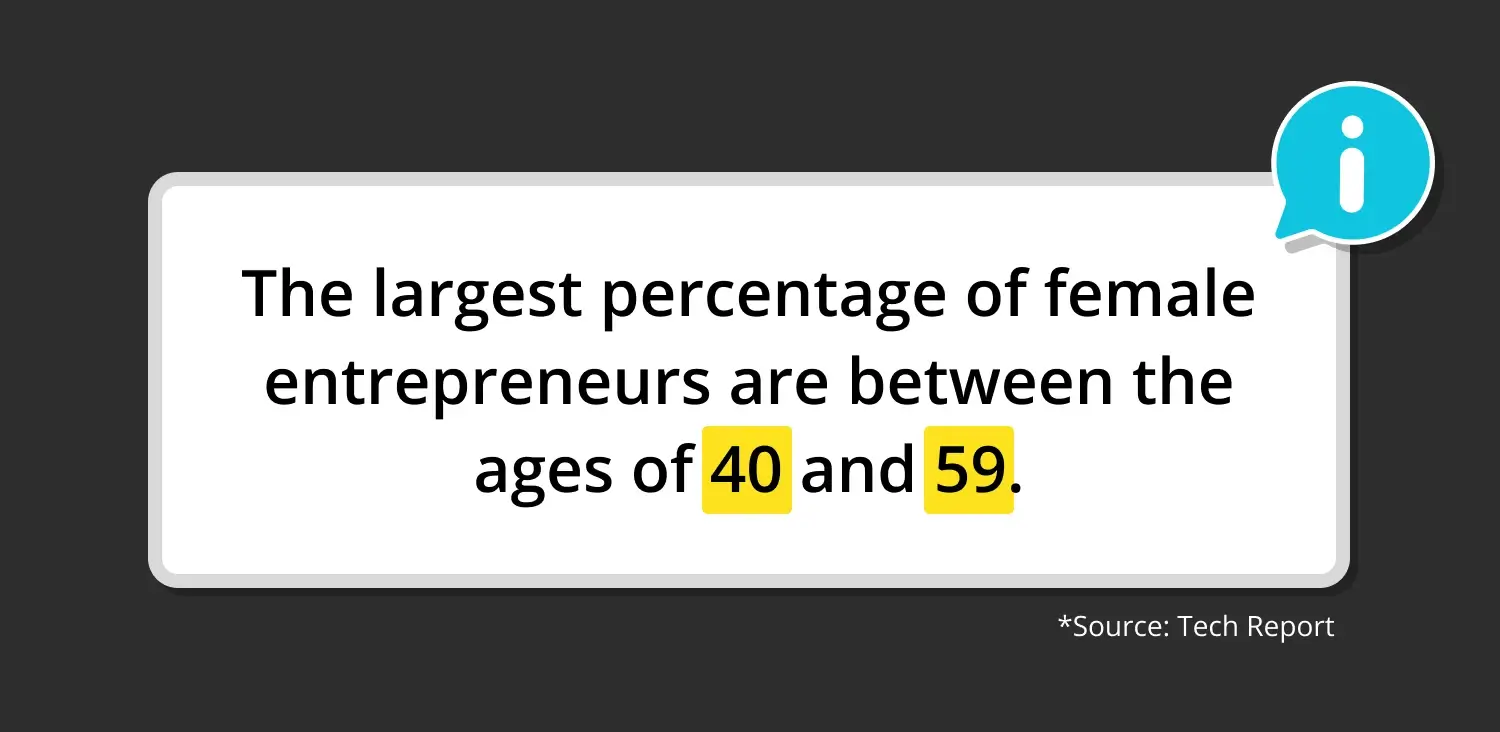
Source: TechReport
Gen Z entrepreneurship statistics
Gen Z's innovative ideas resulting from the effective use of technology carry their businesses forward. Our Gen Z entrepreneurship statistics will encourage you to move away from traditional business models and provide you with new ideas. Now read our Gen Z entrepreneurship statistics and get informed:
48. According to 78% of Gen Z respondents, being an entrepreneur is the most approachable career path (Business Insider).
49. 72% of Gen Z entrepreneurs feel there are fewer economic opportunities for their generation than earlier ones (Square).
50. 93% of Gen-Zers are considering starting their own business (Forbes).
51. With 23% of respondents citing inflation and price increases as their primary issue, small business owners have made inflation and price increases their top difficulty this year (Guidant Financial).
52. About half of Generation Z wants to launch their own company or become an entrepreneur (Samsung Newsroom).
53. Having a secure income is the top priority for 42% of Generation Z (GoDaddy).
54. According to 69% of Gen Z entrepreneurs, online videos and self-directed research were their primary sources of business knowledge (Business Insider).
55. Social good is among the top three business priorities of 50% of Gen Z small business owners (FranchiseWire).
56. 32% of Gen Z respondents said they currently own their businesses, and another 21% said they planned to start their businesses in the upcoming year (GoDaddy).
57. 73% of Gen Z say their primary source of income comes from their enterprise (Square).
58. 92% of Gen Z believe that neurodiversity is essential for business (Forbes).
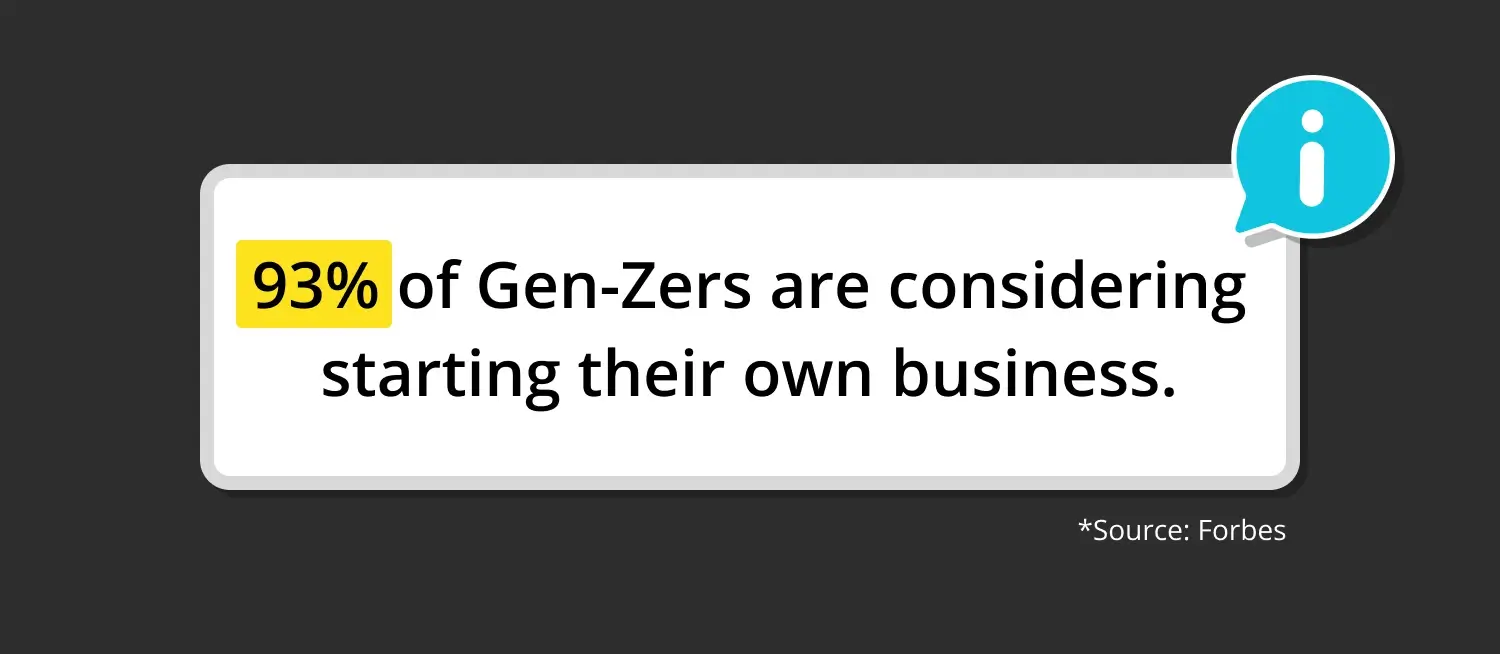
Source: Forbes
Immigrant entrepreneurship statistics
Immigrant entrepreneurs enrich the societies and sectors they are involved in by bringing different ideas and concepts. They also reduce unemployment by creating new employment opportunities and contributing to their environment. Now examine the immigrant entrepreneurship statistics that will give you the opportunity to make inferences:
59. Compared to immigrants, who had a 0.58% rate of new business creation, native-born Americans had a 0.32% rate in 2021, or 320 new business owners for every 100,000 adults (Statista).
60. At least one immigrant founder was involved in 55% of the 1 billion dollar startup companies in the United States (National Foundation For American Policy).
61. People from minority ethnic groups are more likely to have founded businesses after March 2020 (GoDaddy).
62. The number of immigrant entrepreneurs in 2019 was 3.2 million (New American Economy).
63. The retail sector (24%) and accommodation and food services (37%) had the highest percentage of immigrant owners (US Small Business Administration Office of Advocacy).
64. Approximately 13% of the 18.5 million immigrants employed in the EU in 2018 were independent contractors (OECD).
65. Immigrants founded 28% of Main Street businesses (The Immigrant Learning Center).
66. In 2019, minorities owned 19.6% of employer companies, roughly 1.1 million firms (US Small Business Administration Office of Advocacy).
67. The number of people employed in migrant-owned enterprises was 8 million in 2017 (New American Economy).
68. Even though they only make up 13.6% of the country's population, immigrants are thought to be responsible for 25% of its entrepreneurs (American Immigration Council).
69. In 2018, there were 2.9 million self-employed immigrants in the EU, compared to about 2.2 million in 2009 (OECD).
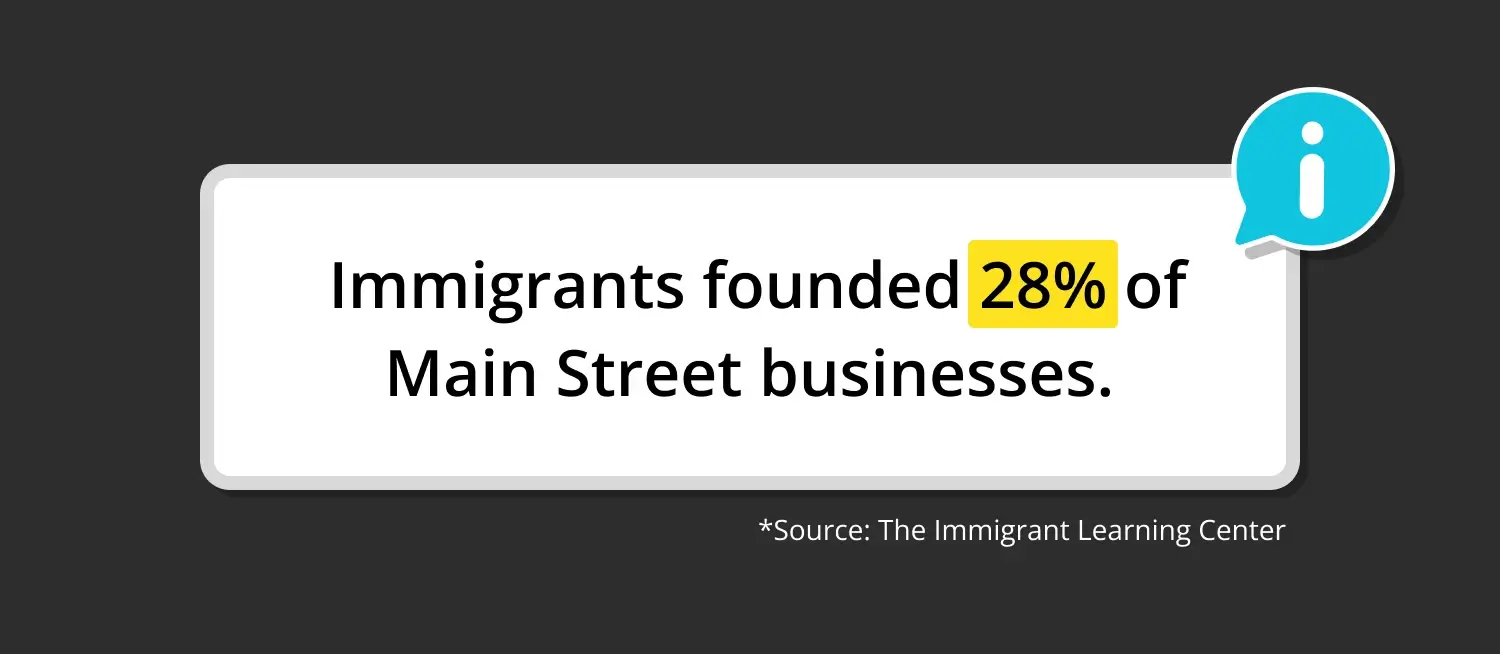
Source: The Immigrant Learning Center
Entrepreneurship statistics worldwide
The number of people turning to entrepreneurship worldwide has increased dramatically in recent years. People prefer entrepreneurship in their careers to achieve financial independence and realize their dreams. You can see how to achieve your goals by examining our statistics. Here are entrepreneurship statistics worldwide:
70. Over 89% of entrepreneurs work weekends globally (Fundera).
71. 38% of respondents claimed that self-discipline and 37% said people and communication skills are essential for becoming a successful entrepreneur (Apollo Technical).
72. 52% of entrepreneurs worldwide think they pay too much in taxes (National Business Capital).
73. According to four out of five entrepreneurs worldwide, social and environmental sustainability is considered when making business decisions (Global Entrepreneurship Monitor).
74. While large businesses created 10.3 million net new employment between 1995 and 2021, small businesses created 17.3 million (US Small Business Administration Office of Advocacy).
75. 96% of entrepreneurs said they have no desire to return to a "regular job" (FreshBooks).
76. Labor is the largest expense for businesses, accounting for over 70% of their budget (North One).
77. Around 10 million social enterprises exist worldwide (World Economic Forum).
78. 77% of small enterprises connect with their customers on social media (Forbes).
79. Long-term success rates for new businesses in the private sector typically range from 10% to 20% (Exploding Topics).
80. 44% of business owners hold a college degree (North One).
81. Every year, social entrepreneurs produce over 2 trillion dollars in revenue in addition to having a positive impact (World Economic Forum).
82. Spanish is the most often spoken foreign language among entrepreneurs at 45.2%. French is the second most common, at 9.4%, while Chinese is the third, at 7.3% (Zippia).
83. Over 81% of respondents said they worked at night, indicating that most business owners put in far more work than the typical worker (Fundera).
84. 55% of entrepreneurs claim to offer the services that the local community in their area needs (GoDaddy).

Source: Fundera
Entrepreneurship failure rate
Failure is quite common in the entrepreneurial world. Among the factors that lead businesses to failure are not addressing the right market and not correctly determining the wants and needs of the target audience. You can prevent your business's failure due to the inferences you will make from our statistics. Now, take a look at our entrepreneurship failure rate statistics:
85. In 2024, 17% of small business owners said their sales decreased (Guidant Financial).
86. The survival rate of new businesses has remained relatively unchanged over the previous 25 years (Zippia).
87. 29% of people choose to become entrepreneurs because they want to be their own bosses (Apollo Technical).
88. Entrepreneurs with a history of failure have a 20% startup success rate (Exploding Topics).
89. 67.7% of newly established businesses made it through at least two years on average between 1994 and 2020 (US Small Business Administration Office of Advocacy).
90. Storefront business owners spent $100,000 on average, while mobile business owners spent $92,500 on average (Business.org).
91. Inconsistent revenue is a concern for 35% of entrepreneurs (FreshBooks).
92. Entrepreneurs who have previously launched successful businesses typically have a 30% success rate in their future endeavors (Exploding Topics).
93. The capital or cash flow required to sustain the business with 29% and poor teamwork and communication with 23% are the biggest reasons why companies fail (Apollo Technical).
94. A loss of revenue has been recorded by 17% of small business owners, demonstrating how consumer spending and overall business performance have been impacted by economic uncertainty (Guidant).
95. 49% of entrepreneurs struggle with mental health issues (Zippia).
96. Over 20% of firms fail in their first year of operation because there is no demand for their products or services (Apollo Technical).
97. The two-year survival rate for young employer establishments from 2017 to 2019 was 79% (US Small Business Administration Office of Advocacy).
💡If you are curious about startup failure statistics, check out our article for more information.

Source: Exploding Topics
US entrepreneurship statistics
Entrepreneurship in the US sets an example for the whole world with its creative ideas and cultural diversity. The large consumer market in the US has enabled the development of entrepreneurship. Here are US entrepreneurship statistics for you to get ideas:
98. There are 31 million entrepreneurs in the United States, or roughly 16% of the adult labor force (North One).
99. In America, entrepreneurship is generally seen favorably, with 63% of people thinking it's a wise career choice (Apollo Technical).
100. Women-owned businesses in the US are creating jobs, directly supporting 23 million people, and contributing close to $3 trillion to the economy (The World Bank).
101. There are 12.3 million women-owned enterprises in the United States (Tech Report).
102. Health, Beauty, and Fitness (9%), Business Services (11%), Food and Restaurant (12%), Retail (11%), and Residential and Commercial Services (7%) are the top five industries in the US where new small businesses are opening (Guidant Financial).
103. In the US, 99.9% of companies are small businesses (US Small Business Administration Office of Advocacy).
104. In 2021, the percentage of new business owners among Americans with less than a high school diploma was 0.66% (Statista).
105. In the US, 58% of small enterprises begin with less than $25,000 (Exploding Topics).
106. A record 5.5 million high enterprises were started by the people who quit their jobs during the Great Resignation in the US (Punks & Pinstripes).
107. 23% of entrepreneurs are dissatisfied with corporate America, a significant factor driving them to start their own businesses (Guidant Financial).
108. The United States has 33,185,550 small businesses as of 2023 (US Small Business Administration Office of Advocacy).
109. 15.6% of adult Americans who are between the ages of 18 and 64 are business owners (Zippia).
110. The United States has the greatest failure rate among startups in the technology sector (Exploding Topics).

Source: Apollo Technical
Entrepreneurship in Europe statistics
Entrepreneurship is encouraged and favored in Europe due to the large market in almost every sector. Entrepreneurs grow their companies by creating solutions that respond to the existing market's needs. Here are entrepreneurship in Europe statistics for you to get information:
111. The number of businesses operating in the non-financial commercial economy of the European Union in 2021 was estimated to be 22.65 million, a minor increase over 2020 but a decrease of almost 200,000 from 2019 (Statista).
112. Although women make up 52% of the European population overall, they only make up 34.4% of independent contractors and 30% of start-up entrepreneurs (We Gate).
113. Nearly one in five people in OECD countries and one in nine people in the European Union (EU) anticipated starting a business during the following three years between 2018 and 2022 (OECD).
114. With 31.5 million active businesses, the EU's business economy included 3.4 million new businesses in 2021 or 11% of the total (Eurostat).
115. While 46% of young individuals in the EU between the ages of 15 and 30 would contemplate starting their own business, very few have actually done so (European Union).
116. In the non-financial business economy of Europe, micro-sized companies with one to nine employees made up about 93.5% of all businesses as of 2022 (Statista).
117. A little over 7% of EU citizens are in the process of starting a new business (OECD).
118. Women make up 15.5% of European entrepreneurs (Startups & Places).
119. Medium-sized companies with more than 50 but fewer than 250 employees made up 0.9% of all businesses in the EU (Eurostat).
120. Germany has by far the highest number of large enterprises operating in its non-financial business economy among all EU member states, with an estimated 11,599 large businesses with 250 or more employees as of 2022 (Statista).

Source: Startups & Places
Final words
Entrepreneurship gives you flexibility and allows you to implement your creative ideas. With the 120+ entrepreneurship statistics we have prepared for you, you will learn how to become a successful entrepreneur. You will also learn how to contribute to your community with your enterprise.
Now that you have learned everything you need to know about entrepreneurship, you are ready to make your dreams come true!
forms.app, your free form builder
- Unlimited views
- Unlimited questions
- Unlimited notifications

